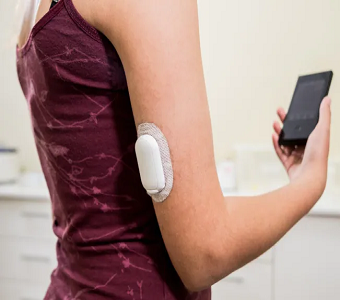In a prior note, we shared how weight-loss drugs might impact obesity related markets. The hype craze has pushed additional data that is now being blown out of proportion. Big pharma, primarily Novo Nordisk and Eli Lilly, need to get weight loss drugs on Medicare schedules for reimbursement. Billions of revenue dollars are dependent on insurance covering obesity medication. As a result, studies will continue to be published pointing to the incredible effects of GLP-1s. While we believe that weight loss drugs will have an impact on obesity related markets, they will not completely eradicate these parallel markets. We buy the hype, but are not fooled by it.
GLP-1 Therapy Increases Access to CGM
At the Wells Fargo Healthcare Conference (read transcript here), Dexcom (DXCM) CFO explained how continuous glucose monitoring (CGM) technology is helping type 2 diabetes patients on GLP-1s. Patients who initiate GLP-1 therapy are seeing CGM utilization increase, not decrease.

This is a surprising trend because it was originally thought that GLP-1 therapies would result in patients not using CGM technologies. Dexcom has traded down 23% from the peak in July 2023 because of fears that GLP-1 medication would eat away at their addressable type 2 diabetes market.
According to Dexcom's data however, GLP-1 + CGM helps doctors and patients understand the impact of the weight loss drugs, drive behavioral change, and minimize rebound effect. With a CGM, patients and doctors understand what is happening in the patient’s body and whether they would revert back to weight gain and glucose levels.
Remember, one of the big challenges with GLP-1 drugs that the weight loss is regained as patients come off the drug. CGM has helped drive behavioral changes so that patients can keep the weight off. This is the data Dexcom is pushing, anyway.
Optum, a division of UnitedHealth, covers about 20% of the commercial lives in the US. According to their data, Dexcom claims that when people with T2D initiate GLP-1 therapy, their CGM utilization tends to increase.
It's still relatively early to determine how patients will react to GLP-1 and CGM utilization. These are trends that will take a few years to play out. For the time being, Dexcom's CGM business is safe from the GLP-1 reach.
A Study Showing GLP-1 Delays Onset of Type 1 Diabetes
The New England Journal of Medicine published a small study that saw GLP-1 drug semaglutide eliminate insulin after meals in all 10 patients and daily insulin in 7/10 patients. The market took this dataset of 10 people to mean that GLP-1 could delay/cure Type 1 diabetes.

In diabetes type 1, the pancreas does not make insulin, because the body’s immune system attacks the beta-cells in the pancreas that make insulin.
It’s important to note that the above study specifically looked at newly diagnosed T1D patients, who are still producing some insulin at this early stage. T1D patients are symptomatic during this "honeymoon period" but beta cells have not completely been depleted yet. As a result, newly diagnosed T1D patients are still able to keep blood sugar levels under control. The study also included carb restriction which could also prolong beta-cell function.
With a sample of 10 newly diagnosed T1D patients, carb restrictions and GLP-1 therapy, it's no surprise that insulin was not needed. This is a patient population that is expected to have a transitory effect. It's also unclear that the effect came from solely GLP-1. The more likely effect is that GLP-1 + carb restriction could delay the killing of beta cells. However, this is a temporary halt and not a cure since T1D is a progressive disease. At best, GLP-1 may delay the need for mealtime insulin by ~12 months, but even that is debatable with this data set.
Current data shows that 43% of patients receiving once-weekly GLP-1 injections continue treatment for 12 months. The majority of patients (>50%) do not continue GLP-1 therapy after 12 months. This could be due to the high out-of-pocket cost, or the gastro-intestinal side effects (nausea, vomiting etc). The relatively low adherence rate needs to be taken into account when looking at studies that claim GLP-1 impacts parallel markets.

The real world scenarios are different that what the studies portray. When more than half of patients get off GLP-1 after a year, they see weight gain and glucose metrics go back to levels that require parallel technologies like CGM/pumps for control.
Access This Content Now
Sign Up Now!




